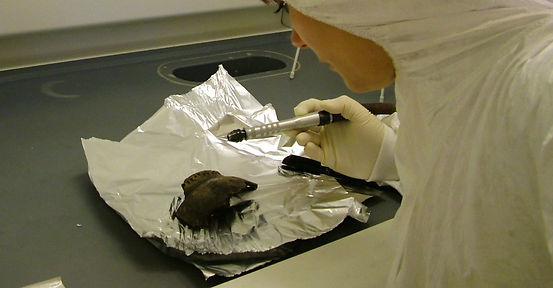 |
|---|
Lipid residue analyses can be performed on the drilled powder from the fabric of a vessel, and any preserved charred remains adhering to the interior. Plant microfossil analysis can only be performed on the interior charred deposit. The protocol for sampling both is outlined below.
Sampling can be carried out in the field/museum although it is generally easier to send the sherds here where we can sample under controlled conditions - as the levels of archaeological organic residues are generally low we need to take precautions to avoid contamination.Lipid analysis is destructive and is based upon solvent extraction of powdered ceramic-absorbed residues or visible residues. However, most analysts will leave a portion of the sample for future analysis.
Sampling Protocols

Charred deposits
-
Place a clean sheet of tinfoil on a work surface, and clean the area with ethanol or dichloromethane.
-
Using a clean scalpel, scrape the surface of the ceramic to remove the carbonised deposit (example, right) onto the tinfoil.
-
Decant the deposit into a clean glass vial, or wrap the deposit in the tinfoil and label with a sample number.
-
The sample number should include: site code, vessel code, type of sample (interior/exterior).
-
Take examples of exterior soot as well as interior foodcrust, in order to act as a control.
-
The analysis for plant microfossils uses approx. 5mg of deposit. Lipid analysis uses a similar amount, so if both analyses are being performed a sample of approx. 10mg is desirable.
Drilled ceramic fabric
-
It is possible to work with very small samples (0.1 g) of sherd powder for lipid residue analyses.However, when starting out, we would advise a ceramic sample size of between 1-2 grams.
-
We drill an area of approximately 1X1cm to acquire this sample size (example, left).
-
Use a Dremmel drill fitted with a tungsten abrasive bit (solvent cleaned between samples) to remove a fine powder to a depth of 2mm.
-
Collect the sherd powder on aluminium foil before transferring to a glass vial.
-
Label using the same conventions as those for charred deposits.


Lipid analysis is based on the survival and recognition of molecules common to many sources around us in the contemporary world.
For example, fingerprints will deposit lipid molecules, such as fatty acids, cholesterol and wax esters onto the surfaces of samples.
Therefore, if at all possible minimize or even exclude handling of samples intended for analysis. Use the end of a trowel or tweezers (neoprene gloves may be hard to find in the field).
Handling sherds
Washing
Avoid washing sherds intended for organic analysis. Washing could dislodge surface residues, remove more labile constituents of absorbed residues and introduce contaminants. Avoid cleaning sherds with hydrochloric acid as this is likely to bring about the removal of organic components. During recording, please avoid pen and varnish on the inner surface of the sherd.
Archaeological considerations
In order to maximise the potential for archaeological interpretation, it is extremely helpful to note the fabric type and to know what part of the vessel the sherds derives (e.g. rim, body or base).
Equally important is for sherds to be sampled from stratigraphically well-established contexts. Some use regimes (e.g. boiling) are likely to lead to differential deposition of lipid within the wall of the pot.
Ideally, whole vessel profiles will allow multiple sampling of a single vessel, although such samples are not easy to come by so consideration must be given to whether up to three 1-2 gram samples can be removed and powdered.
Some sherds display visible surface deposits on their interior surface. This is often burnt organic matter and lipids do tend to be preserved in these carbonaceous matrices.
Separate extraction of the visible surface material does allow for comparison with the lipid absorbed in the pot matrix.
We have also experimented with so-called ‘concentration gradients’ – longitudinal sections through the potsherd from the inside to the outside. This is helpful where soil samples are not available.
High concentrations of lipid in the interior sections compared to the outer sections support the view that the vessel came into contact with lipid-rich substances.
Finally, sooting on the outer surfaces of potsherds/vessels is useful in suggesting activities associated with heating the containers and may assist in interpreting the lipid distribution.
